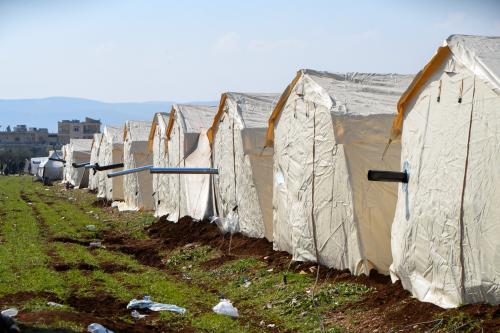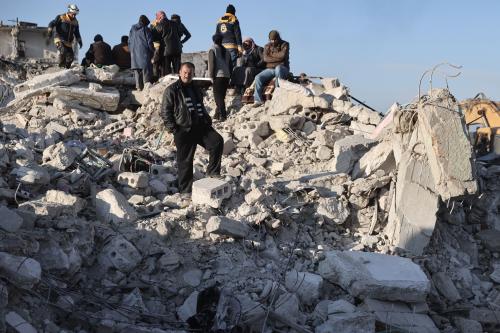In February, following the peace conference in Geneva between the Syrian opposition and the regime of Bashar al-Assad, Syrian government helicopters dropped round after round of crude “barrel bombs” — metal drums filled with explosives — on Aleppo. The devastation set off what aid workers called one of the largest waves of refugees out of Syria since the beginning of the civil war. Syrians could soon surpass Afghans as the largest refugee population in the world: nearly 2.6 million, according to the United Nations High Commissioner for Refugees (UNHCR). The Turkish government expects nearly 1.5 million of them to be in Turkey by the end of 2014.
Turkey is already home to some 800,000 Syrian refugees, making it the world’s sixth-largest refugee-hosting country last year. Although Jordan hosts nearly as many Syrians, and Lebanon significantly more, the Turkish government, unlike its Arab neighbors, has never opened its borders to refugees from the Middle East in this way. Since 2011, the Turkish government has built well-ordered refugee camps. It has offered free health care and, for some refugees, education and also provided them with legal status and protection for the first time. Last year, Ankara passed a new migration law that created a government agency to take over the management of the Syrian influx and process applications for individual asylum seekers.
Turkey deserves praise for its generous open-door policy, which was equal parts charity and opportunity for the government of Prime Minister Recep Tayyip Erdogan to project influence in Syria and throughout the Middle East. But it cannot afford to maintain its refugee policies indefinitely. Its camps are now filled to capacity, Assad has dug in, diplomatic progress has stalled, and the opposition that Turkey so staunchly supported has all but frayed. As refugees continue to pour into the country, with no sign that Syrians will voluntarily go home amid the current chaos, Turkey must address the long-term status of Syrians within its borders, especially the majority of Syrian refugees who are not registered with the UNHCR or the government and are not living in refugee camps.
Open Door Policy
Turkey is no stranger to asylum seekers and refugees. It received more than half a million Muslims and ethnic Turks who left Greece in the early 1920s, a similar number of refugees from the Balkans during the following decades, roughly 320,000 Bulgarian Turks who fled Bulgaria just before the collapse of the country’s communist government in 1989, and 450,000 Iraqi Kurds who escaped Saddam Hussein’s massacres in the early 1990s. But the flow of Syrian refugees into Turkey is unprecedented for two reasons. First, the number of refugees who have arrived and the speed at which they have done so exceed that of any other crisis. Second, Turkey has never held its door open so wide for refugees from outside Europe.
Focusing on refugee camps misses a crucial point: the majority of Syrians in Turkey aren’t even in any of them.
In previous refugee crises, the Turkish government would typically build some camps and then send refugees home as soon as it was safe. With the Syrians, however, Turkey created a new whole infrastructure for handling refugees. As of February, the government had created 22 camps in ten provinces managed by its Disaster and Emergency Management Presidency. In total, the camps hold over 220,000 people. The majority of the camps are located along Turkey’s border with Syria in the southern provinces of Sanliurfa, where three camps house more than 75,000 refugees, Gaziantep, where four camps house almost 34,000 refugees, and Kilis, where two camps house around 37,000 refugees.
The camps have gotten a lot of international attention. But focusing on them misses a crucial point: the majority of Syrians in Turkey aren’t even in any of them. Instead, an estimated 65 percent of Syrians refugees have moved into Turkish cities and towns; many individuals live in makeshift housing shared with at least seven other people. In the neighborhood of Tarlabasi, in the heart of Istanbul, many Syrian families squat in abandoned buildings. One family of seven described to one of us their home, a room about five by ten feet, as a place for those “who have no other choice but death.” Most Syrians don’t live in camps because there simply is not enough room in them. But refugees also choose to live in Turkish towns and cities for other reasons. Some wealthier Syrians are able to pay for accommodation; others look for work that the camps don’t offer. Syrians may also be motivated by the presence of family or community members, a desire to maintain mobility, and uncertainty about their future.
The arrival of so many urban refugees has changed the faces of neighborhoods throughout Turkey. In some cities, including Kilis, near the Syrian border, the population has almost doubled. And in the bustling neighborhood of Aksaray, in Istanbul, new bakeries, businesses, travel agencies, and restaurants run by Syrians line the main boulevard, creating a mini Aleppo. Many Syrians recognize that they will be in Turkey for the foreseeable future — and therefore want to adapt. (A recent government survey found that 86 percent of refugees outside of camps want to learn Turkish.) The Syrians in Turkey are no longer refugees waiting for a war to end but rather immigrants who are ready to write a new chapter in their lives.
Welcome Guests
When Syrians first entered Turkey in 2011, they were considered “guests.” That legal designation was previously used for the Kurdish refugees who had fled Turkey for northern Iraq in the early 1990s. By designating Syrians as “guests,” the Turkish government believed it would not be obligated to extend the international standards of protection to refugees as defined by the UNHCR, which provide a legal basis for refugees to stay in the country and ensure that they won’t be forced to return to their home country. In November 2011, however, the Turkish government changed course and granted that temporary protection status to Syrian refugees. The Turkish government’s move also gave temporary protection to Palestinian refugees from Syria (nearly 250,000 Palestinian refugees in Syria have been displaced by the war, though many remain in the county).
In April 2013, Ankara went further and passed a comprehensive new migration law that established an entire legal system to protect and aid asylum seekers in Turkey. Previously, the government had dealt with asylum seekers without any substantive legal guarantees or procedures such as judicial reviews of administrative decisions. Under the law, a new government department, the General Directorate of Migration Management, would handle Syrian refugees and oversee the implementation of these new legal provisions. The law, which the government was already considering before the Syria crisis and prepared in close consultation with the UNHCR, the European Court on Human Rights, and civil society groups, has been upheld by those organizations as a model how to protect refugee rights.
But temporary protection and the new asylum law still leave many Syrians in limbo. Implementation remains uneven and refugees have no recourse if they are denied temporary protection status. The legal reforms don’t address the invisibility of Turkey’s urban refugees, whose exact needs, from food to shelter and education, are unknown. What’s more, temporary protection status does not allow Syrians to work easily in Turkey. A recent government survey of Syrians living outside refugee camps found that 77 percent of respondents had looked for a job. Syrians have already become an exploited underground labor force, as evidenced by rapidly falling wages for workers in industries such as construction, textile manufacturing, heavy industry, and agriculture. In Kilis, daily rates for such labor declined from an estimated 60 Turkish lira (about $28) before the mass arrival of refugees to just 20 lira (about $9) late last year. The Gaziantep Chamber of Commerce recently recommended that Syrians be given formal and legal short-term working permits, vocational training, and social security benefits. Their proposal includes setting an employment quota for Syrian refugees in all local business and building industrial zones near the border for public-private partnerships that would employ Syrian refugees and produce goods that could then be sold to Syria. The proposal, however, is only in its earliest stages. Many details would still need to be worked out.
Aiding Ankara
At a time when Turkey is providing so much to so many refugees, the international community cannot lag behind. As of February, Ankara had spent approximately $2.5 billion hosting Syrian refugees. The United States has provided $1.3 billion in humanitarian assistance to all Syrian refugees; the European Union, including the EU Commission and individual member states, has given around $3.6 billion. Those numbers look impressive, but according to the UNHCR, it has only received 14 percent of the funding needed to address the refugee crisis.
Syrians in Turkey are no longer refugees waiting for a war to end but rather immigrants who are ready to write a new chapter in their lives.
Sharing the burden means more than sending money. It also means resettlement. Turkey has opened its borders to refugees even as the European Union has placed strict limits on Syrian refugees as part of a broader policy to block out migrants and asylum seekers. Four years into the Iraq war, there were two million Iraqi refugees — and the EU resettled 8,400 of them. As the Syrian civil war enters its fourth year, there are around 2.6 million Syrian refugees. The EU has pledged to resettle 16,000 of them, but pledges don’t always guarantee resettlement. Australia, Canada, the United States, and some Scandinavian countries have resettled approximately 48,000 refugees from Turkey between 1995 and 2013, primarily Iranians and Iraqis. All these countries should open their borders to Syrian refugees in Turkey seeking new lives.
Turkey should also boost its coordination with international nongovernmental organizations working in the country. For now, international NGOs face difficult circumstances in Turkey. As of late last year, ten international NGOs were registered in Turkey, but many of them complain about working with the government. It can take more than a year for NGOs to receive permission from the interior ministry to operate in the country, and there is no legislation that regulates them.
According to the UNHCR, only two international NGOs — the Danish Refugee Council and International Medical Corps — have even been allowed into southern Turkey. But the International Crisis Group says that many international NGOs operate in the southern Turkey in “various guises” with an “informal green light from local Turkish authorities.” Some NGOs partner with local Turkish ones, such as Ortak Akil and Turkey’s International Blue Crescent, in order to reach populations in need.
The influx of Syrian refugees into Turkey over the last three years is unlike anything the country has ever experienced. The government has done much to help Syrians so far — but it can and should do more to ensure that the humanitarian assistance is more sustainable. As the number of Syrians in Turkey continues to rise, Ankara should attend more to the majority of refugees outside camps — and that could start with an assessment of how many Syrians are living among Turks, from Gaziantep to Istanbul, how they are surviving, and what exactly they need. Failure to do so could undermine the government’s generous and much-publicized aid. And it could further destabilize a conflict that gets more volatile by the day. Turkey opened its doors to Syrian refugees because it wanted to be seen as a new leader in the region. It’s time for Turkey to follow through.
This article originally appeared in
Foreign Affairs
.


Commentary
Northern Exodus: How Turkey Can Integrate Syrian Refugees
April 15, 2014